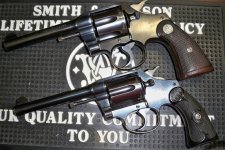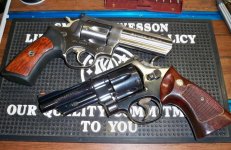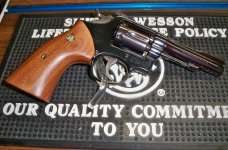I generally do a lot of side-by-side comparison of different loads but admittedly haven't compared the same load in several firearms all that often. Last weekend my son and I went to the gong range at the ranch and we took some "fun" iron along; some of which doesn't get out of the safe often.

Colt Official Police circa 1932 5-inch barrel
Colt Police Positive circa 1922 5-inch barrel

S&W K38 Combat Masterpiece circa 1956 4-inch barrel

Ruger GP100 4-inch barrel circa 1995
S&W Model 27-3 4-inch barrel circa 1983
The common load chronographed was .38 Special, WW brass, 148 grain FBWC (Brazos brand - coated), Federal SP, and VV N350 at 4.5 grains. I make no recommendation or endorsement of this load but rather provide it for purely informational purposes.
The Colt Police Positive averaged 773 fps and a std. dev. of 36
The Colt Official Police averaged 890 fps with std. dev. of 30
The Combat Masterpiece averaged 833 fps and std. dev. of 22
The GP100 averaged 752 fps with std. dev. of 31
The Model 27 averaged 822 fps and a std. dev. of 25
I did not anticipate differences of over 100 fps even though barrel length varied by an inch. No real "relative" surprises with the possible exception of the Colt Police Positive lagging so far behind the Colt Official Police. They are both in excellent "shooter" condition but the Positive has a noticeably larger cylinder gap though I did not measure the difference. Honestly, the Positive feels almost like a toy compared to the Official. I see why they were both popular; the Positive because it is incredibly light to carry, and the Official because if you were actually in a gunfight you'd want this one compared to its lighter cousin.
I thought the Combat Masterpiece and the Model 27 did really well seeing they've an inch less barrel than the Official Police. They are both "shooters" and quite tight. You have to hold them both just right to the sun to see the barrel/cylinder gap. Love the GP100 but it's a bit "looser" than the others accounting perhaps for its lower velocities.
Trying to be as objective as possible the Combat Masterpiece is the most "fun" to shoot of this group followed closely by the Official Police. For whatever reasons I tend to shoot them both pretty well. Love the Model 27 too!
Bryan
Colt Official Police circa 1932 5-inch barrel
Colt Police Positive circa 1922 5-inch barrel
S&W K38 Combat Masterpiece circa 1956 4-inch barrel
Ruger GP100 4-inch barrel circa 1995
S&W Model 27-3 4-inch barrel circa 1983
The common load chronographed was .38 Special, WW brass, 148 grain FBWC (Brazos brand - coated), Federal SP, and VV N350 at 4.5 grains. I make no recommendation or endorsement of this load but rather provide it for purely informational purposes.
The Colt Police Positive averaged 773 fps and a std. dev. of 36
The Colt Official Police averaged 890 fps with std. dev. of 30
The Combat Masterpiece averaged 833 fps and std. dev. of 22
The GP100 averaged 752 fps with std. dev. of 31
The Model 27 averaged 822 fps and a std. dev. of 25
I did not anticipate differences of over 100 fps even though barrel length varied by an inch. No real "relative" surprises with the possible exception of the Colt Police Positive lagging so far behind the Colt Official Police. They are both in excellent "shooter" condition but the Positive has a noticeably larger cylinder gap though I did not measure the difference. Honestly, the Positive feels almost like a toy compared to the Official. I see why they were both popular; the Positive because it is incredibly light to carry, and the Official because if you were actually in a gunfight you'd want this one compared to its lighter cousin.
I thought the Combat Masterpiece and the Model 27 did really well seeing they've an inch less barrel than the Official Police. They are both "shooters" and quite tight. You have to hold them both just right to the sun to see the barrel/cylinder gap. Love the GP100 but it's a bit "looser" than the others accounting perhaps for its lower velocities.
Trying to be as objective as possible the Combat Masterpiece is the most "fun" to shoot of this group followed closely by the Official Police. For whatever reasons I tend to shoot them both pretty well. Love the Model 27 too!
Bryan



